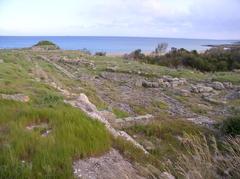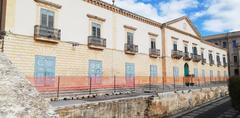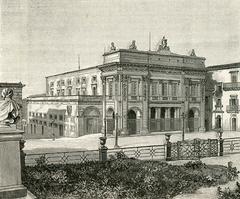Castelluccio di Noto Excavations: Visiting Hours, Tickets, and Historical Insights
Date: 04/07/2025
Introduction
Set amidst the rolling countryside between Noto and Palazzolo Acreide in southeastern Sicily, the Castelluccio di Noto excavations represent one of the island’s most significant archaeological sites. Dating back to the Early Bronze Age (c. 2300–1700 BCE), Castelluccio di Noto is the type-site of the “Castelluccio Culture,” renowned for its extensive necropolis of over 200 rock-cut tombs, unique funerary art, and evidence of advanced prehistoric civilization. The site not only offers a window into early Sicilian life, but also anchors broader Mediterranean connections, with artifacts indicating trade and cultural exchange from Malta to Anatolia.
This guide provides all the essential information you need to plan your visit, including Castelluccio di Noto visiting hours, ticket details, accessibility tips, and travel recommendations. You’ll also find historical context, highlights of the archaeological discoveries, and guidance on nearby attractions—ensuring a complete cultural experience in the region. For those who wish to explore further, artifacts from Castelluccio are displayed at the Museo Archeologico Regionale “Paolo Orsi” in Syracuse.
Whether you’re an archaeology enthusiast, a history buff, or a curious traveler, Castelluccio di Noto is an essential stop on any Sicilian itinerary. Stay up to date and enhance your exploration with tools like the Audiala app and by consulting local tourism resources (Hermes Sicily; La Freccia Verde; Visit Italy).
Contents
- Historical Background
- Discovery and Archaeological Investigations
- Castelluccio Culture: Chronology and Characteristics
- Settlement Layout and Necropolis Features
- Funerary Practices and Symbolism
- Trade and Mediterranean Connections
- Planning Your Visit
- Visiting Hours and Tickets
- Guided Tours and Accessibility
- Directions and Transportation
- Nearby Attractions
- Archaeological Highlights
- Architectural Features and Key Finds
- Material Culture and Technological Advances
- Later Historical Layers
- Visitor Tips and FAQs
- Ongoing Research and Conservation
- Visiting Castelluccio Palace in Noto
- Summary and Resources
Historical Background
Discovery and Archaeological Investigations
The Castelluccio di Noto site was first systematically explored by Paolo Orsi in the late 19th century, whose innovative methods set a new standard for prehistoric archaeology in Sicily (Academia.edu). Orsi’s investigations revealed a fortified settlement and a vast necropolis, establishing the area as the defining example of the Early Bronze Age Castelluccio Culture.
Excavations throughout the 20th century—most notably by Giuseppe Voza in the 1990s—have unearthed hundreds of ceramics, elaborate tombs, and evidence of advanced domestic architecture. The ongoing research continues to reshape our understanding of prehistoric societies in the Mediterranean.
Castelluccio Culture: Chronology and Characteristics
The Castelluccio Culture thrived from around 2300 to 1700 BCE, characterized by distinctive matt-painted ceramics, often decorated with geometric motifs in earthy tones. The settlement featured circular and bi-apsidal huts, advanced building techniques, and specialized craft production. Ritual artifacts, including carved bones and greenstone axes, reflect complex social and spiritual structures, with connections to Malta, Troy, and the wider Aegean.
Settlement Layout and Necropolis Features
Perched on a natural rocky plateau, the settlement exploited its defensible position and panoramic views of the Iblean landscape. The necropolis consists of over 200 artificial cave tombs (tombe a grotticella artificiale), carved into limestone cliffs along the Cava della Signora. These chamber tombs—often sealed with decorated stone doors and spiral motifs—served as collective burial spaces and mimic the forms of contemporary dwellings.
The most famous tomb, the “Tomba del Principe” (Tomb of the Prince), boasts a monumental façade with false pillars, symbolizing the community’s architectural and social sophistication.
Funerary Practices and Symbolism
Burial customs involved sealing the tombs with spiral-carved stone slabs, interpreted as symbols of regeneration or fertility. Grave goods—ceramics, bronze ornaments, and bone artifacts—reflect social stratification and the importance of ritual. The necropolis design emphasizes ancestor veneration and a cyclical conception of life and death.
Trade and Mediterranean Connections
Artifacts at Castelluccio di Noto suggest active participation in early Mediterranean trade networks. Imported objects and stylistic influences point to connections with Malta, Anatolia, and the Aegean, while evidence of mining and metallurgy in the region demonstrates advanced technological capabilities (Hermes Sicily).
Planning Your Visit
Visiting Hours and Tickets
- Hours: The site is generally open from 9:00 AM to 6:00 PM, Tuesday through Sunday. Closed on Mondays and public holidays. Seasonal variations may apply.
- Tickets: Entrance is often free, but guided tours or special events may require a fee. It is strongly advised to check with local tourism offices or Hermes Sicily for up-to-date schedules and booking options.
Guided Tours and Accessibility
- Guided Tours: Available by reservation, guided tours provide expert insights into the site’s history and archaeology.
- Accessibility: The terrain is uneven and rocky, with steep paths that may be challenging for those with limited mobility. Comfortable shoes and sun protection are recommended.
Directions and Transportation
- By Car: From Noto, follow the provincial road toward Testa dell’Acqua and Rigolizia, following signs to the Castelluccio estate.
- By Public Transport: Local buses run from Noto, but service is limited; check schedules in advance.
- Parking: Available near the entrance.
Nearby Attractions
- Baroque Noto: A UNESCO World Heritage city renowned for its architecture, vibrant festivals, and cuisine.
- Cava d’Ispica: Archaeological and natural reserve with additional prehistoric sites.
- Monte Casale: Another Bronze Age settlement.
- Museo Archeologico “Paolo Orsi”: Home to many artifacts from Castelluccio (Hermes Sicily).
Archaeological Highlights
Architectural Features and Key Finds
- Hut 8: The largest and most complex domestic structure, featuring a “house within a house” layout.
- Egg-shaped Storage Jar: Contained Italy’s oldest known olive oil, dating to the end of the 3rd millennium BCE.
- Rock-cut Tombs: Over 200 chamber tombs with spiral-carved doors, including the monumental Tomba del Principe.
- Matt-painted Ceramics: The hallmark of Castelluccio material culture.
Material Culture and Technological Advances
Castelluccio’s inhabitants produced sophisticated ceramics, stone tools, and ornamental objects. The discovery of olive oil residue points to agricultural innovation, while evidence of trade reflects integration into wider Mediterranean networks.
Later Historical Layers
The strategic plateau continued to be occupied into the medieval period. The ruins of a 14th-century castle built by Giovanni Landolina and the nearby “Grotta dei Santi” (Cave of the Saints) with medieval frescoes attest to the site’s enduring importance (La Freccia Verde).
Visitor Tips and FAQs
Tips
- Allocate 2–3 hours to fully explore the necropolis, settlement, and castle ruins.
- Bring water, sun protection, and sturdy shoes.
- Spring and autumn offer the best climate for visits.
- There are no on-site facilities; plan accordingly.
FAQ
Q: What are the visiting hours?
A: Typically 9:00 AM–6:00 PM, Tuesday–Sunday. Confirm seasonal hours locally.
Q: How do I get tickets?
A: Access is often free, but guided tours require advance booking through local providers.
Q: Is the site accessible for people with disabilities?
A: The terrain is challenging; contact the visitor center for assistance.
Q: Are guided tours available?
A: Yes, via reservation through local operators like Hermes Sicily.
Ongoing Research and Conservation
Continued archaeological research at Castelluccio di Noto is deepening our understanding of prehistoric Sicily. Conservation efforts focus on stabilizing fragile structures and preserving decorated tombs. Key artifacts are displayed at the Museo Archeologico Regionale “Paolo Orsi” in Syracuse (Notoinforma).
Castelluccio Palace in Noto: Hours, Tickets, and Cultural Highlights
The Aristocratic Legacy
Built in 1782, Castelluccio Palace (Palazzo Castelluccio) exemplifies Sicilian Baroque grandeur and was once home to the influential Di Lorenzo family (Following the Rivera). The palace’s ornate architecture, grand salons, and restored interiors reflect the social, political, and cultural aspirations of Noto’s nobility.
Restored in the 21st century by Jean-Louis Remilleux, the palace now functions both as a museum and a cultural hub, hosting events and exhibitions that celebrate Sicily’s artistic heritage (Following the Rivera).
Baroque Aesthetics and Symbolism
Palazzo Castelluccio is a textbook example of Sicilian Baroque, designed to impress with its dramatic facades, intricate stonework, and luminous interiors (Eupedia). The palace’s restoration has faithfully preserved its 18th- and 19th-century decorative schemes, allowing visitors to experience the opulence and social rituals of the Sicilian aristocracy (The Thinking Traveller).
Visitor Information
- Hours: Guided tours are offered from 10:00 AM to 6:00 PM, Tuesday–Sunday. Closed Mondays.
- Tickets: €10–€15 per person, with discounts for students and seniors. Book online or at the palace, but advance reservations are advisable.
- Accessibility: Some areas have limited wheelchair access; contact the palace in advance for assistance.
- Location: Via Camillo Benso Conte di Cavour, central Noto, within walking distance of the cathedral (Following the Rivera).
- Tours: All visits are guided; photography is allowed without flash or tripods.
Combine your visit to Castelluccio Palace with a stroll along Corso Vittorio Emanuele and stops at Noto’s cathedral, artisan shops, and cafes.
Summary and How to Plan Your Visit
Castelluccio di Noto offers an immersive journey into Sicily’s Early Bronze Age, revealing the sophistication, artistry, and interconnectedness of prehistoric Mediterranean societies. With its dramatic necropolis, monumental tombs, and evocative settlement remains, the site provides a rare glimpse into the island’s ancient past. The addition of nearby Baroque marvels like Castelluccio Palace and the city of Noto itself ensures a rich and varied cultural itinerary.
Visitor Checklist:
- Confirm visiting hours and book guided tours in advance.
- Wear suitable footwear and bring sun protection.
- Allow time to explore both the archaeological site and Noto’s Baroque treasures.
- Consult local tourism offices and digital applications like Audiala for the latest updates and resources.
For further information, official updates, and to enhance your visit, consult these resources:
- Hermes Sicily – Guide to the Necropolis of Castelluccio di Noto
- La Freccia Verde – Il Villaggio Preistorico di Castelluccio e i suoi Dintorni
- Visit Italy – Noto and Surroundings
- Notoinforma – Castelluccio di Noto Archaeological Site
- Academia.edu – Paolo Orsi Innovatore
- Following the Rivera – Best Things to Do in Noto, Sicily
- Eupedia – Noto
- The Thinking Traveller – Noto
- Viaggio in Sicilia – Infiorata di Noto
Plan your journey to Castelluccio di Noto and discover Sicily’s unparalleled archaeological and cultural heritage.




